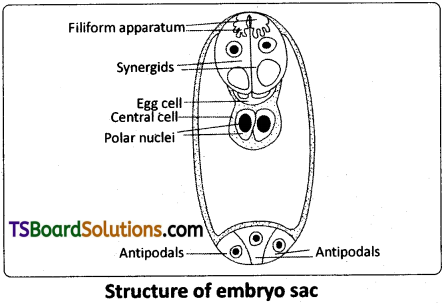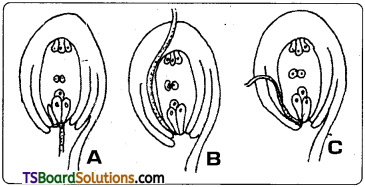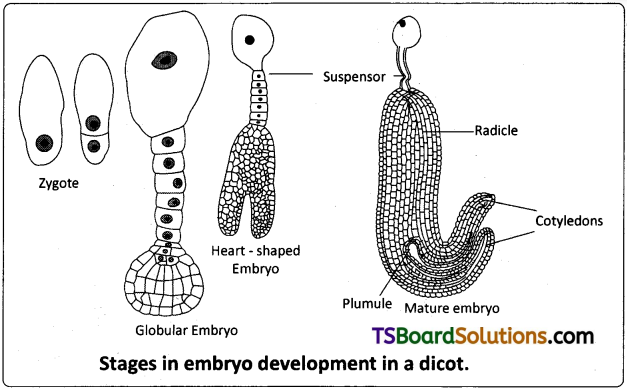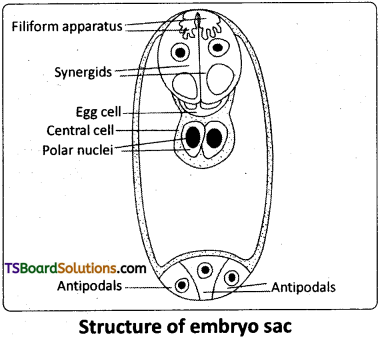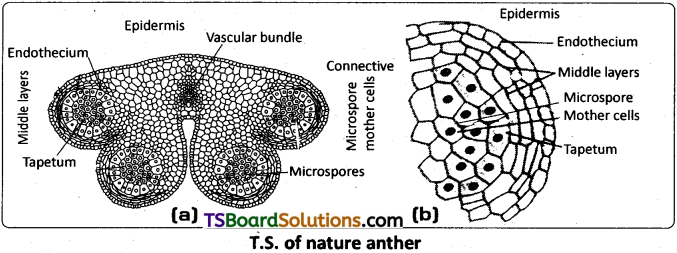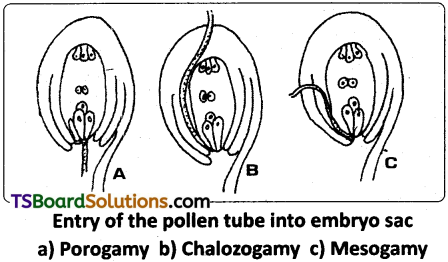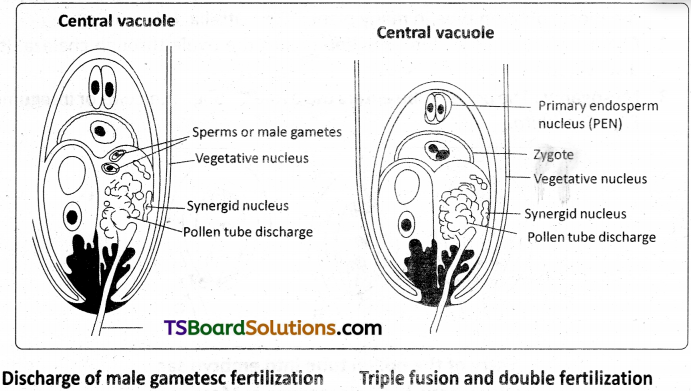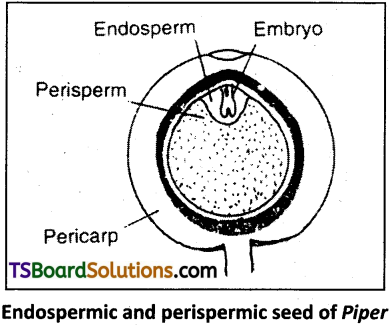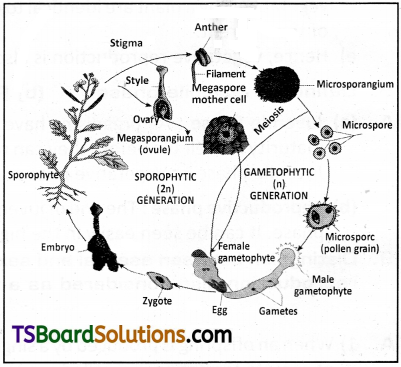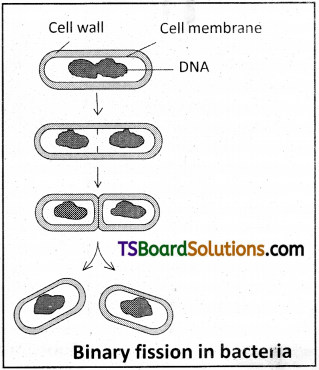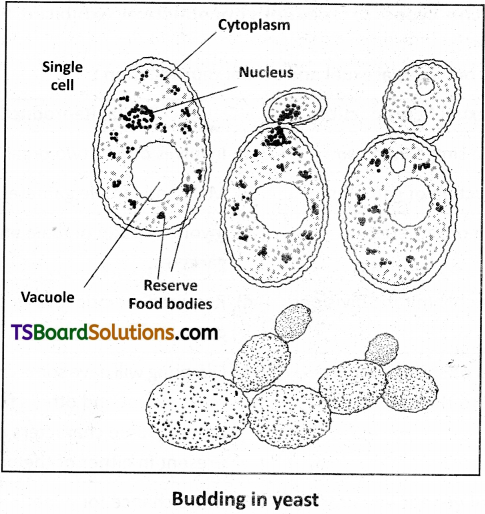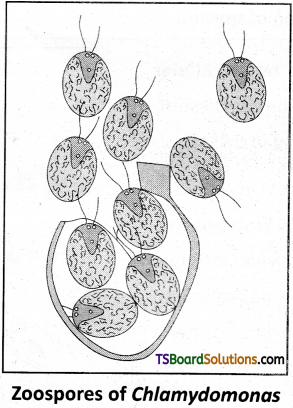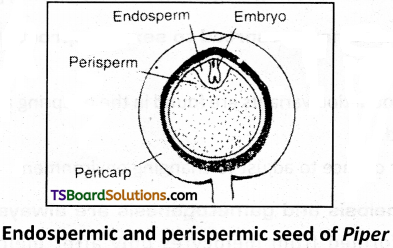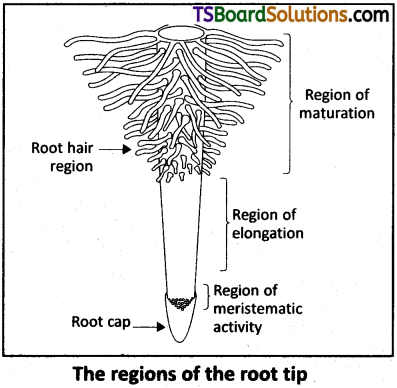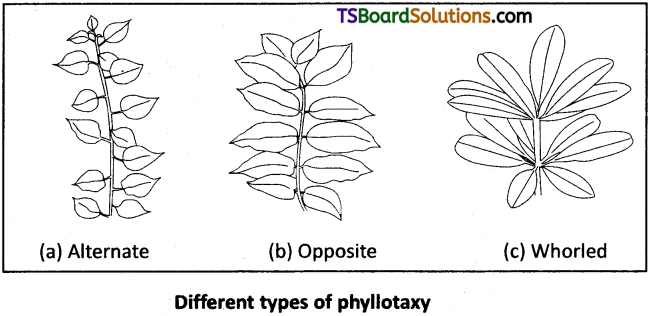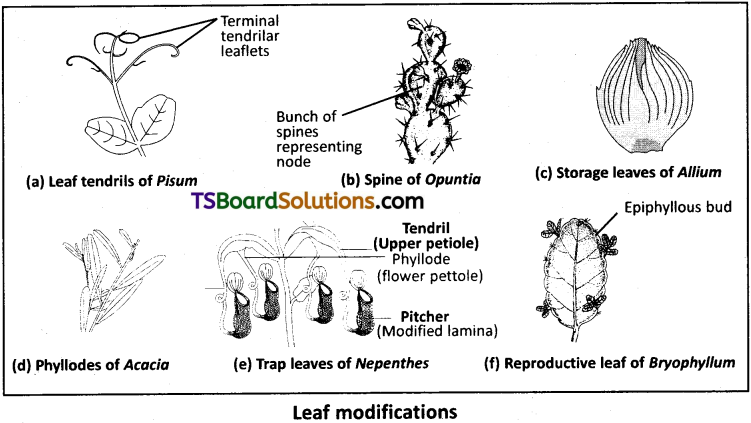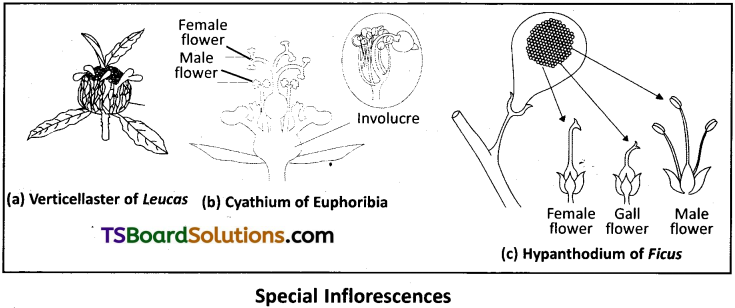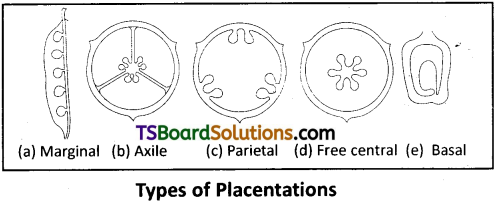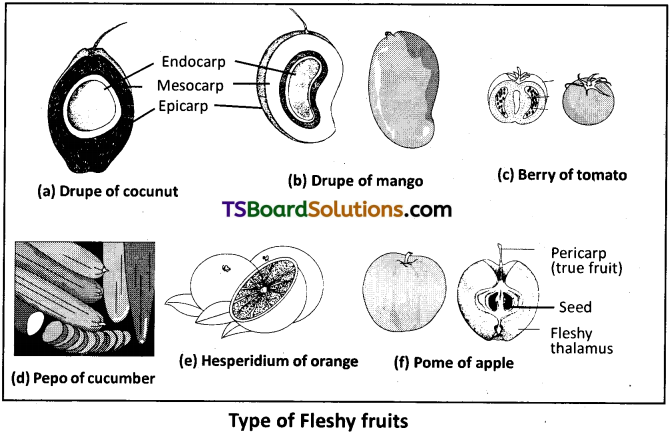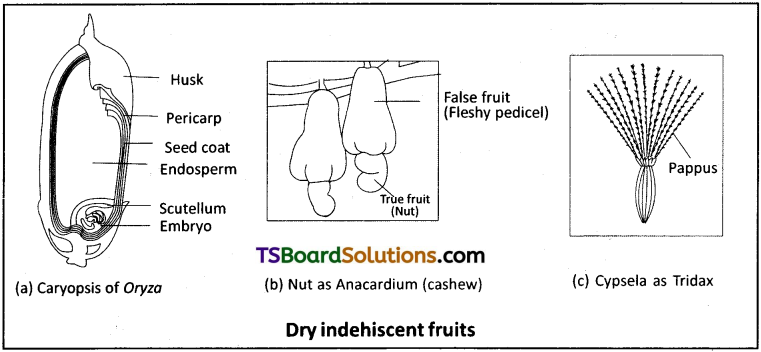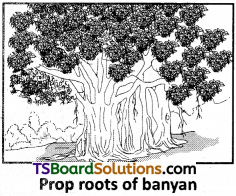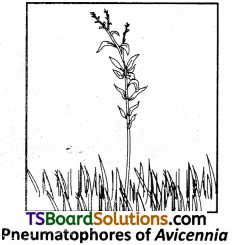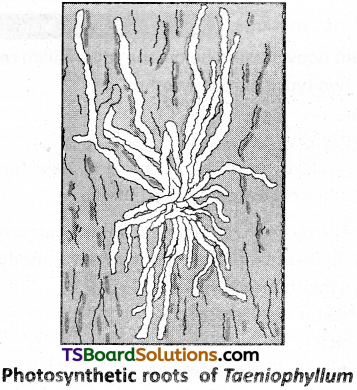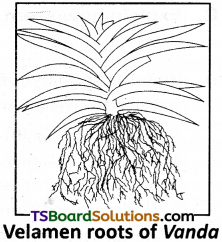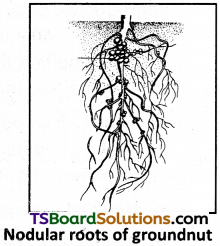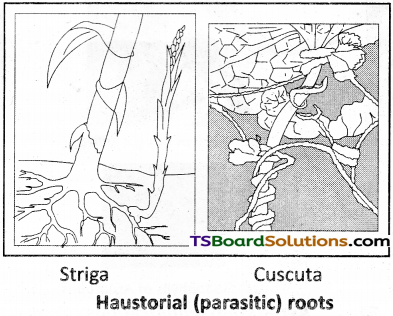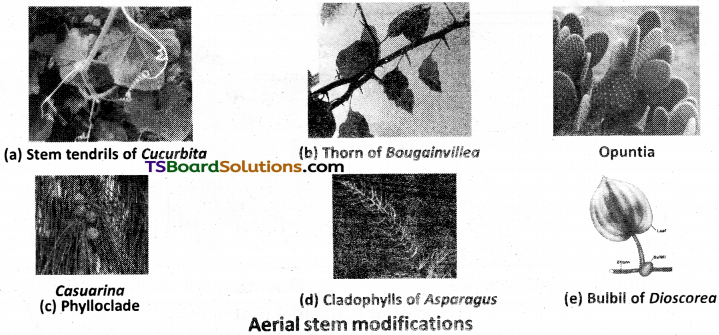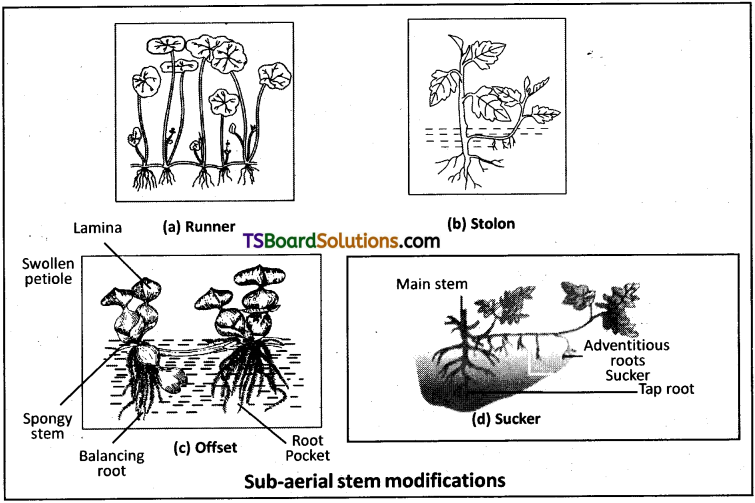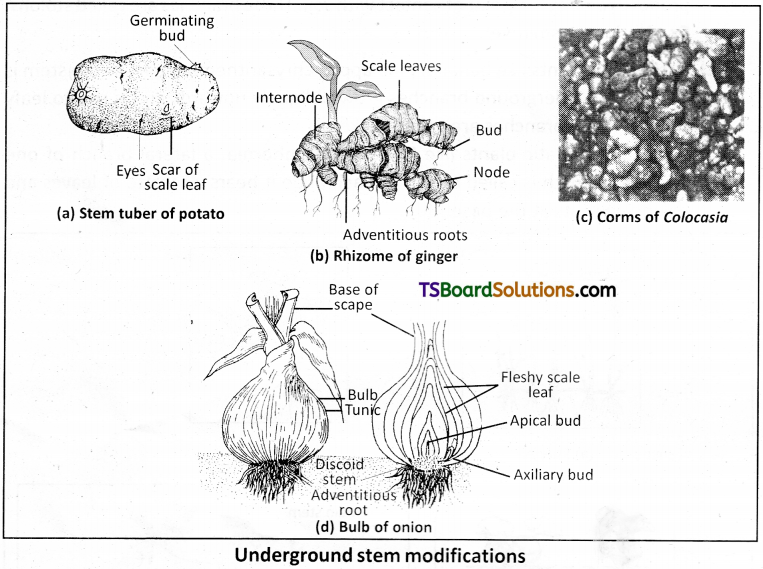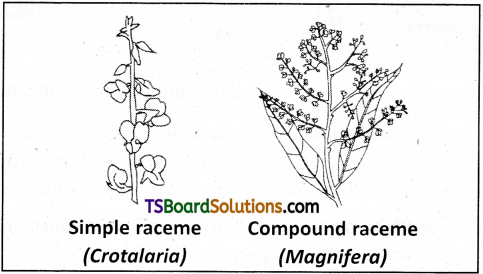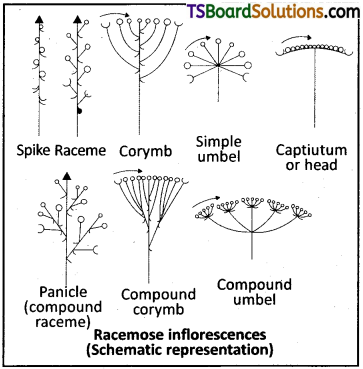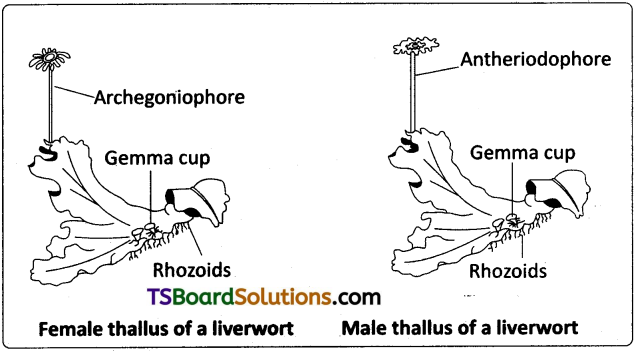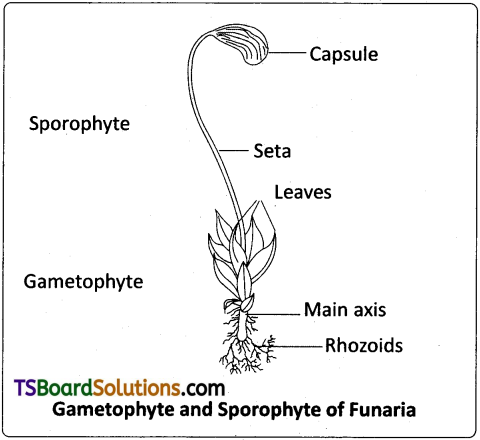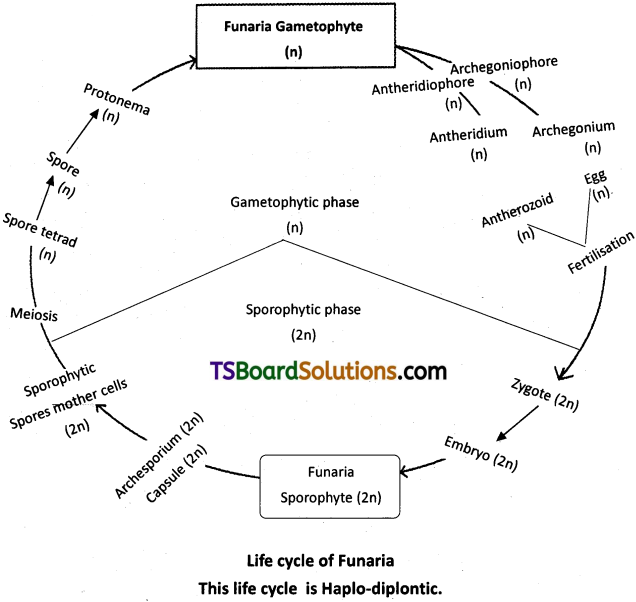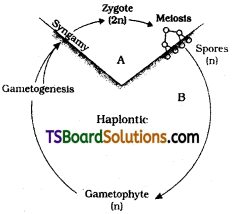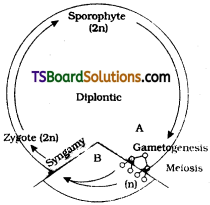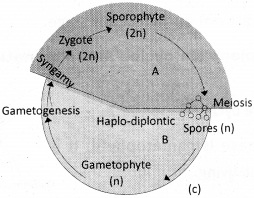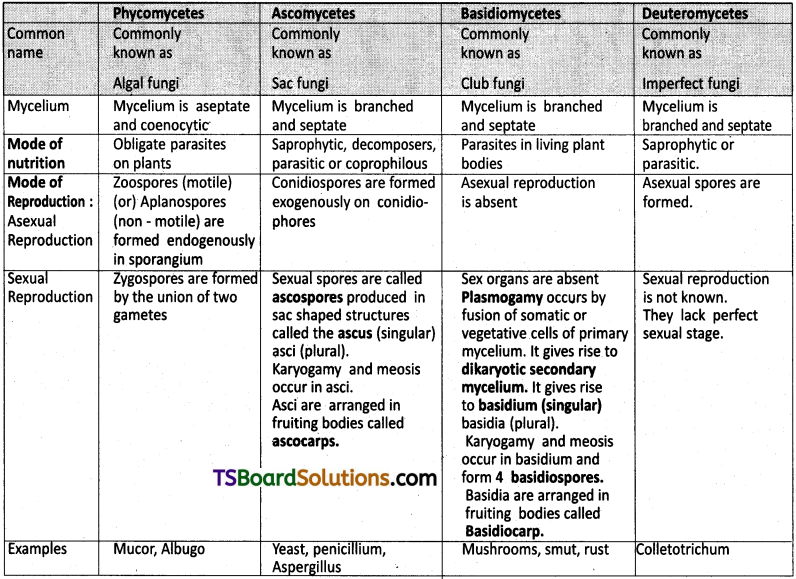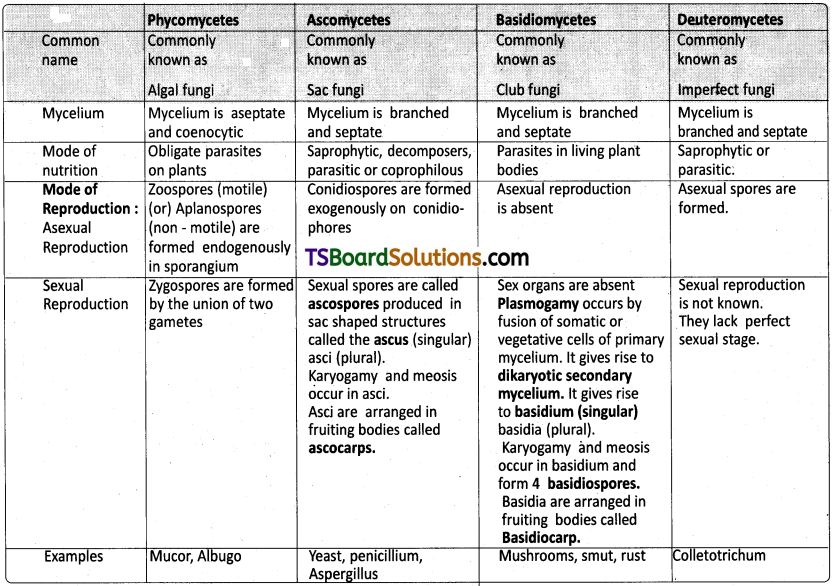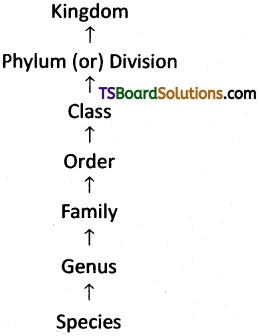Telangana TSBIE TS Inter 1st Year Botany Study Material 8th Lesson Taxonomy of Angiosperms Textbook Questions and Answers.
TS Inter 1st Year Botany Study Material 8th Lesson Taxonomy of Angiosperms
Very Short Answer Type Questions
Question 1.
What is ‘Omega Taxonomy’? [Mar. – 2019, ’18, ’15, ’13 – AP]
Answer:
Taxonomy based on information from other branches such as Embryology, Cytology, Palynology, Phytochemistry etc., in addition to morphological characters is called Omega Taxonomy.
Question 2.
What is Natural system of plant classification? Name the scientists who followed it. [May 14]
Answer:
- The system in which plants are grouped on the basis of their natural relationships taking all possible morphological characters into consideration is known as Natural system of classification.
- de Jussieu, de Candolle and Bentham and Hooker followed it.
Question 3.
Explain the scope and significance of “Numerical Taxonomy”.
Answer:
- Numerical Taxonomy uses mathematical methods to evaluate observable differences and similarities between taxonomic groups. It is now easily carried out using the computers is based on all observable characters.
- In this process no. and codes are assigned to all the characters and the data are then processed. Each character is given equal importance and at the same time hundreds of characters can be considered.
Question 4.
What is geocarpy? Name the plant which exhibits this phenomenon. [May 17, Mar. 17 – A.P ; Mar. 15 – T.S]
Answer:
Development of fruit inside the soil is known as geocarpy. Eg: Arachis hypogea (groundnut).
Question 5.
Name the type of pollination mechanism found in members of Fabaceae. [Mar. 14]
Answer:
- Piston mechanism for cross pollination.
- It is entomophilous, occurs with the help of insects.
![]()
Question 6.
Write the floral formula of solanum plant. [Mar 2020]
Answer:
![]()
Question 7.
Give the technical description of ovary in solanum nigrum.
Answer:
- Bicarpellary, syncarpous, bilocular, superior ovary.
- Placentata swollen with many ovules on axile placentation. Style Carpels are arranged obliquely at 45°.
Question 8.
Give the technical description of anthers of Allium cepa.
Answer:
Anthers are dithecous, basifixed, introse and dehiscence is longitudinal.
Short Answer Type Questions
Question 1.
Write a brief note on semi technical description of a typical flowering plant. [Mar. – 2019]
Answer:
The plant is described beginning with its habit, habitat, vegetative characters, floral characters followed by fruit. After describing various parts of a plant, a floral diagram and a floral formula are presented.
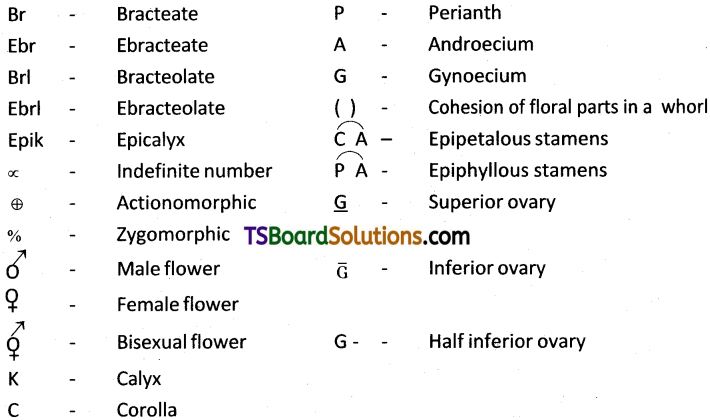
Floral formula indicates the number of free or united members of corresponding whorl as subscript of the respective symbols. It also shows cohesion and adhesion.
Floral diagram provides information about the no. of parts of a flower, their arrangement and their relation with one another.
Question 2.
Describe the non-essential floral parts of plants belonging to Fabaceae.
Answer:
The non-essential floral parts are calyx and corolla.
Calyx :
Sepals five in number, Gamosepalous (sepals united), valvate aestivation. The odd sepal is anterior in position.
Corolla :
Petals five in number, Polypetalous (Petals are free), descending imbricate aestivation. Corolla is Papilonaceous. The posterior petal is the largest and is called ‘Vexillum or Standard Petal’. The two lateral petals are called ‘Wings or Alae’. The two boat shaped petals beneath the wings on the anterior side are called ‘Keel or Carina’. The keel petals are fused and enclose the essential organs.
![]()
Question 3.
Give an account of floral diagram.
Answer:
Floral diagram :
It provides information about the number of parts of a flower, their arrangement and the relation they have with one another. The mother axis represents the posterior side of the flower and is indicated as a dot or a circle at the top of the floral diagram. Successive whorls represent calyx, corolla, androecium and gynoecium. Gynoecium at the centre represents T.S. of ovary. The bract represents the anterior side of the ovary.
Question 4.
Describe the essential floral parts of plants belonging to Liliaceae. [Mar. ’20, 18, 17, 15]
Answer:
The essential floral parts are Androecium and Gynoecium.
Androecium :
Stamens are six, arranged in two whorls of three each. They are free or epiphyllous, anthers are dithecous, basifixed, introrse and dehiscence is longitudinal.
In Allium, the stamens are inserted at the base of the tepals which are also fused at the base.
Gynoecium :
Overy is tricarpellary, syncarpous, superior, trilocular with numerous ovules on axile placentation. The style is terminal and stigma is trifid and capitate. The ovary has septal nectaries, one on each septum.
Question 5.
Write a brief account on the class of Dicotyledanae of Bentham and Hooker’s classification.
Answer:
The class Dicotyledonae are characterised by tap root, reticulate venation, tetramerous or pentamerous flowers and two cotyledons in a seed. On the basis of the number of whorls in the Perianth and the condition of petals, the dicotyledons are divided into three sub-classes namely Polypetalae, Gamopetalae and Monochlamydae. Polypetalae was divided into three series namely 1) Thalamiflorae, 2) Disciflorae and, 3) Calyciflorae, Gamopetalae was divided into three series viz. 1. Inferae 2. Heteromerae and 3. Bicarpellatae. Monochlamydae was divided into eight series.
Question 6.
Explain Floral formula.
Answer:
1. The floral formula is represented by some symbols of floral parts.
2. In the floral formula :
a. Br stands for bracteate; Ebr for ebracteate (Bracts absent)
b. Brl stands for bracteolate; Ebrl for ebracteolate (Bracteoles absent)
c. ⊕ stands for actinomorphic; % for zygomorphic
![]()
e. K stands for calyx; C for corolla.
f. A for androecium and G for gynoecium.
g. G stands for superior ovary and \(\overline{\mathrm{G}}\) for inferior ovary and G – for half inferior or half superior.
3. Floral formula also indicates the number of free or united (within brackets) members of the corresponding whorl as subscript of the respective symbol.
4. It also shows cohesion (union among similar members) and adhesion (union between dissimilar members).
![]()
Question 7.
Give economic importance of plants belonging to Fabaceae. [May ’17, May 14 ; Mar. ’13]
Answer:
1. Pulses :
Pulses like red gram, black gram, green gram, bengal gram are rich source of proteins.
2. Oil :
Groundnut oil from groundnut (Arachis hypogaea) seeds and soyabean oil from seeds of soyabean (Glycine max) are used in cooking.
3. Vegetables :
Pods of bean (Dolichos), soyabean (Glycine max) are used as vegetables.
4. Fodder :
Many plants are used as fodder (Crotalaria & Phaseolus).
5. Fibres :
from Crotalaria (sun-hemp) is used in making ropes.
6. Medicine :
Seeds of Trigonella (Menthi) are used as condiment and medicine. The leaves are used as vegetables.
7. Commercially & Products :
Commercially important products obtained are viz., blue dye (Indigofera tinctoria), yellow dye (Butea monosperma)
8. Medicine :
Medicine is obtained from Derris indica.
9. Green manure :
Sesbania and Tephrosia are used as green manure.
10. Wood :
Wood from (Pterocarpus santalinus) Red sanders is used for making musical instrument.
Long Answer Type Questions
Question 1.
Describe the characteristics of plants belonging to Fabaceae.
Answer:
Vegetative Characters:
Habit :
Many of them are herbs. Some are shrubs, trees, weak stemmed twinners or tendril climbers.
Root System :
Tap root system having root nodules. These nodules contain symbiotic nitrogen fixing bacteria – Rhizobium.
Stem :
Aerial, prostrate or erect, herbaceous or woody climbers.
Leaves :
Cauline, alternate, stipulate, base pulvinate, petiolate, simple or pinnately compound leaf, venation reticulate.
Floral Characters:
Inflorescence :
Axillary or terminal, raceme.
Flower :
Bracteate, bracteolate or ebracteolate, pedicillate, zygomorphic, complete, bisexual, pentamerous, perigynous cup-shaped thalamus.
Calyx :
Sepals five, gamosepalous, imbricate aestivation, odd sepal anterior.
Corolla :
Petals five, polypetalous, papilionaceous consisting of a large posterior petal (standard or vexillum), two laterals (wings or Alae) two anterior fused petals (keel or Carina) enclosing essential organs, vexillary / descendingly imbricate aestivation.
Androecium :
Stamens 10, usually diadelphous [(9) +1] as in Pisum or monadelphous as in Crotalaria, Arachis, anthers dithecous, introse.
Gynoecium :
Monocarpel I ary, unilocular half superior ovary with many ovules on marginal placentation; Style single, long, terminal; stigma simple.
Pollination :
Protandry in flowers prevent self pollination. But Lathyrus, Pisum are self pollinated. Pollination is entomophily and occurs by Piston mechanism.
Fruit :
Generally legume or pod. In Arachis the pods are indehiscent and geocarpic.
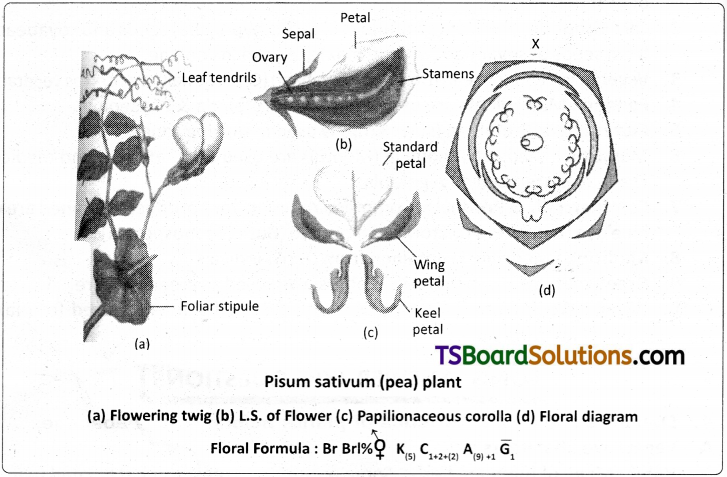
Question 2.
Write about the key characteristics of Solanaceae.
Answer:
- Mostly plants are herbs.
- Presence of hairs on the plant
- Bicollateral vascular bundles in the stem
- Adnation of petioles and pedicels with the internode
- Pentamerous, actinomrophic and hypogynous flowers
- Presence of Persistant calyx
- Epipetalous stamens
- Bicarpellary, syncarpous, superior ovary with obliquely placed carpels
- Presence of false septum in the ovary
- Swollen axile placentation
- Fruit is a berry or capsuie
- Presence of curved embryos
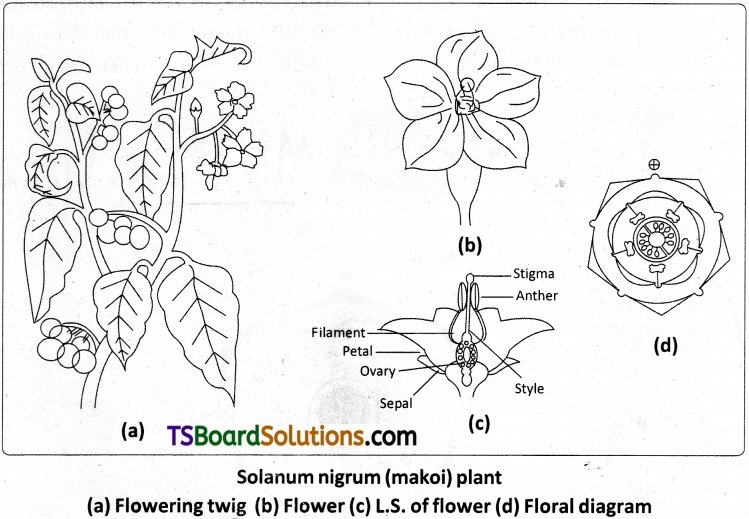
Question 3.
Give an account of the family Liliaceae.
Answer:
Class- Monocotyledonae
Series- Coronariae
Family- Liliaceae
I. Vegetative characters:
1. Habitat and habit :
Mesophytes (Allium, Lilium) and also xerophytes (Asparagus, Ruscus, Aloe)are found in this family. Mostly perennial herbs, shrubs or trees are found in some species of Dracaena, Yucca and Aloe. Few are climbers (Gloriosa, Smilax).
2. Root system :
Adventitious root system. In Asparagus, fasciculated tuberous roots are present,
3. Stem :
Mostly perennial underground stems. It may be a bulb (Allium, Lilium, Scilla), rhizome (Gloriosa), or a corm (Colchicum). Gloriosa and Smilax are tendrillar climbers. Cladophylls are present in Ruscus and Asparagus.
4. Leaf :
The leaves are radical (Allium, Lilium) or cauline (Smilax, Gloriosa). Phyllotaxy is usually alternate (Gloriosa) or whorled (Trillium)Simple, petiolate, stipulate exstipulate, parallel venation (exceptionally reticulate in Smilax). Leaves are succulent in Aloe, Yucca and reduced to scales in Asparagus, Ruscus. Stipules in Smilax and leaf apex in Gloriosa are modified into tendrils. Epiphyllous buds present at leaf apex in Scilla.
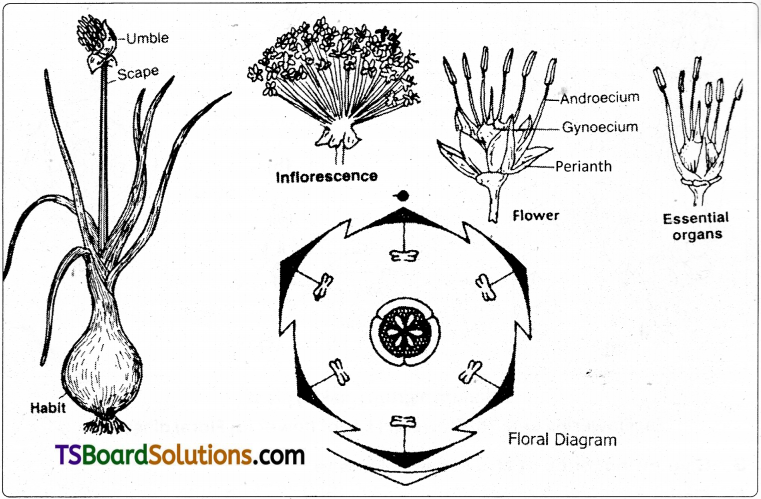
II. Floral Characters:
1. Inflorescence :
Simple raceme (Asparagus) or panicle (Aloe) or umbel (Allium). Solitary, terminal (Lilium) or Solitary, axillary (Gloriosa).
2. Flower :
Bracteate, ebracteolate, pedicellate, actinomorphic, complete, bisexual,
homochlamydeous, trimerous, and hypogynous.
A) Perianth :
Tepals 6 in two whorls, polyphyllous (Lilium) or gamophyllous (Aloe), petaloid. Odd tepal of outer whorl is anterior, Valvate aestivation.
B) Androecium :
Stamens 6 in two whorls of 3 each, free or epiphyllous. Anthers are dithecous, introrse, basifixed and dehisce longitudinally.
C) Gynoecium :
Tricarpellary and syncarpous. Ovary is superior and trilocular with several ovules on axile placentation. Style is terminal and stigma is trifid, capitate. The ovary has septal nectaries.
3. Floral formula :

4. Pollination :
Flowers are protandrous (Allium) or protogynous (Colchicum) or Herkogamy (Gloriosa) to prevent self pollination. Cross pollination is by entomophily. Yucca has a symbiotic type of pollination by a specific moth, Pronuba yuccasella.
5. Fruit :
Berry or capsule. Seed is monocotyledonous.
III. Economic Importance :
1. Edible :
Allium cepa (bulb), Asparagus (roots), cloves of Allium sativum as spice.
2. Medicinal plants :
Allium cepa [bulb – bactericidal), Allium sativum (cloves – gastric and heart.)
3. Colchicine :
Colchicum, autumnale [mutagen obtained from corm]
4. Fibre yielding plants :
Leaves of Yucca and Dracaena.
5. Ornamental plants :
Gloriosa, Lilium, Asparagus, Dracaena.
![]()
Question 4.
Write the characteristics of plants that are necessary for classification. Describe them in brief.
Answer:
Depending upon flowering plants are divided into Non-flowering plants (cryptogamae) and Flowering plants (phaenerogamae)
Sub kingdom :
Cryptogamae (cryptogams): Cryptogams are flowerless and seedless spore plants. They never bear flowers, fruits and seeds. They reproduce asexually by spores and sexually by gametes.
Basing upon the plant body cryptogams are divided into three divisions.
(a) Thallophyta (b) Bryophyta (c) Pteridophyta.
Division Thallophyta :
These are simplest and most primitive plants. All of them have thallus, which is not differentiated into root, stem and leaves.
Division Thallophyta is divided into Algae & Fungi.
Sub division Algae :
Algae are green, photoautotrophic and usually aquatic thallophytes.
Sub division Fungi :
Fungi are non-green (achlorophyllous) heterotrophic . thallophytes.
Division Bryophyta :
Bryophytes are green, autotrophic, embryophytic, nonvascular cryptogams. They are first land plants. They are the amphibians of plant kingdom.
Division Pteridophyta :
Pteridophytes are green, autotrophic, embryophytic, vascular plants.
Sub kingdom Phanerogamae (Phanerogams) :
These are called flowering plants. They bear flowers or cones for reproduction. These phanerogams have one division Spermatophyta.
Division Spermatophyta :
There spermatophytes are seed plants without or with fruits. It is divide into two 1. Gymnospermae 2. Angiospermae.
Gymnospermae (Gymnosperms) :
These are seed plants without ovary and fruit. Seeds are naked without fruit wall.
Angiospermae (Angiosperms) :
These are seed plants with ovaries and fruits. The seeds are enclosed in the fruit wall (pericarp). These are fruit bearing flowering plants.
Depending upon the number of cotyledon in the seed angiosperms are divided into Dicotyledonae and Monocotyledonae.
Class :
Dicotyledonae (Dicot plants) :
Fruit bear seeds with two cotyledons. Tap root system, leaf with reticulate venation, tetra on pentamerous flowers are present.
Class :
Monocotyledonae (Monocot plants):
Fruit bear seeds with one cotyledons; Fibrous root system; leaf with parallel venation; trimerous flowers are present.
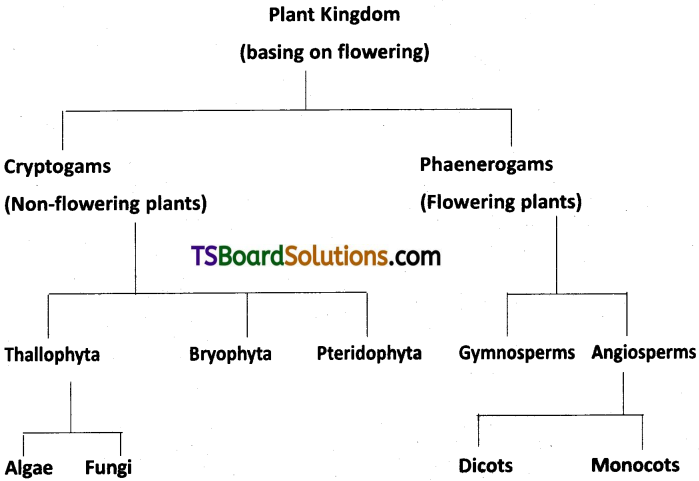
Question 5.
Describe a typical flowering plant in the taxonomic perspective.
Answer:
I. Vegetative characters :
1. Habit –
- Herb / Shrub / Tree
- annual/biennial / perennial
2. Habitat- Hydrophyte/Mesophyte/Xerophyte
3. Root – Tap root system / Adventitious root system, special character like root modification
4. Stem –
- Aerial/ underground / sub – aerial
- Erect / twiner procumbent / prostrate
- Herbaceous / woody
- Special characters and modification
5. Leaf –
- Cauline / ramal / radical
- Phyllotaxy – Alternate / opposite / circular.
- Simple / compound leaf
- Stipulate / exstipulate
- Leaf base – adnate / pulvinate
- Petiolate, sessile
- Reticulate / parallel venation
- Any special characters or modification.
II. Floral characters:
1. Inflorescence :
- Axillary/terminal
- Racemose / cymose / special type
- Inflorescence type
2. Flower in general
- Bracteate /Ebracteate
- Pedicillate / sessile
- Bracteolate / ebracteolate
- Actinomorphic / zygomorphic
- Complete / incomplete
- Bisexual / unisexual
- Pentamerous / tetramerous / trimerous
- Hypogynous / perigynous / epigynous
- Dichlamydeous /monochlamydeous
- Heterochlamydeous / homochlamydeous
- Cyclic / spiral
3. Perianth:
a) Calyx :
- No. of sepals
- United (poly) free (gamo)
- Aestivation – valvate / twisted / intricate
- Persistent / deciduous
- Odd sepal – anterior or posterior
b) Corolla :
- No. of petals
- United (poly) / free (gamo)
- Shape : tubular / ligulate / papilionaceous/ funnel shape.
- Aestivation – valvate / twisted / imbricate
c) Androecium :
- No. of stamens – definite / indefinite
- Arrangement – one whorl / two whorls
- Free / united (monoadelphous / diadelphous / polyadelphous / syngenicious)
- Length – didynamous / tetradynamous
- Epiphyllous/ epipetalpus
- Extrose / introse
- Fertile / sterile
- Anthers : dithecous / monothecous
- Basifixed / dorsifixed versatile.
- Dehiscence – longitudinal / transverse / porous
Gynoecium :
- Mono / bi/ tri / tetra / penta / multicarpellary
- Carpels – United /free
- Mono / bi/ tri / tetra / penta / multilocular
- Superior / half superior / inferior ovary
- Placentation – Axile / central / basal/ marginal
- Style – terminal / basal / lateral
- Stigma – capitate / dumbel shaped / bifid
Fruit :
- Simple / compound / Aggregate
- Fruit type
![]()
Question 6.
Give an account of Bentham and Hooker’s classification of plants.
Answer:
Bentham and Hooker classification is a natural system of classification. It was published in 3 volumes of Genera Plantarum.
They divided flowering plants into 3 classes – Dicotyledonae, Gymnospermae and Monocotyledonae.
Class :
Dicotyledonae :
1. Tap root system 2. Reticulate venation. 3. Flowers tetramerous or pentamerous 4. Seed has two cotyledons Cl. Dicotyledons is divided into 3 sub classes – polypetalae, Gamopetalae and Monochlamydae.
1. Subclass : Polypetalae :
1. Perianth in two whorls.
2. Petals are free.
Sub cl: Polypetalae is divided into 3 series based on the nature of thalamus.
A. Series Thalamiflorae :
Thalamus is elongated, conical or convex.
It has 5 cohorts.
B. Series Disciflorae :
Thalamus is disc shaped.
It has 4 cohorts.
C. Series Calyciflorae :
Thalamus is cup shaped.
It has 5 cohorts.
Family Fabaeceae belongs to order Rosales.
2. Subclass : Gamopetalae :
1. Perianth in two whorls
2. Petals are united.
3. Stamens are epipetalous.
S. Class :
Gamopetalae is divided into 3 series based on the nature of ovary and merosity of flower
A. Series Inferae :
Ovary is inferior.
It includes 3 cohorts.
B. Series Heteromerae :
Ovary is superior.
Carpels are more than two.
It has 3 cohorts.
C. Series Bicarpellatae :
Ovary is superior.
No. of carpels are two.
It has 4 cohorts.
Family Solanaceae belongs to order Polemoniales.
3. Subclass :
Monochlamydeae :
Perianth is not divisible into calyx and corolla. It has 8 series. No cohorts. Families are directly under series.
Class: Gymnospermae :
Seeds are naked. It is divided into 3 families – Cycadaceae, Coniferae & Gnetaceae.
Class : Monocotyledonae :
1. Adventitious root system, 2. Parallel venation, 3. Trimerous flowers and 4. Seed has one cotyledon. It has 7 series. No cohorts. Families are placed directly under the series.
Thus flowering plants are grouped into 202 natural orders now called as families. Of these 165 natural orders belong to Dicotyledonae. 3 to Gymnosperms and 34 belong to Monocotyledonae.
![]()
Question 7.
What is taxonomy? Give a brief account of different types of plant classification.
Answer:
Classification of plants into groups based on their similarities and their relationships is called Taxonomy. It deals with characterization, identification, nomenclature and classification.
On the basis of criteria taken into account, classification systems are 3 types. They are
1. Artificial system of classification :
It is based on one or few comparable characters like morphology or natural habits.
Eg: 1: Classification of plants on the basis of form into herbs, shrubs, trees etc., was done by Theophrastus.
Eg: 2 : Sexual system of Linnaeus.
2. Natural system of classification :
Plants are grouped on the basis of their natural relationship taking into consideration all possible morphological characteristics.
Eg : Classification of de Candolle
Bentham and Hooker system
3. Phylogenetic system of classification :
These systems are proposed after the publication of “Origin of species” and the announcement of the “theory of evolution” by Charles Darwin. Hence they are also called post-Darwinism classifications. They reflect the genetic and evolutionary relationships among the taxa and show them in the form of a phylogenetic tree. Ex : Classification of Engler and Prantl in their “Die Naturlichen Plazenfamilien”. J. Hutchinson in his book “Families of Flowering Plants”. Latest phylogenetic classification is APG (Angiospermic Phylogenetic Group) system.
Other Types:
4. Numerical Taxonomy :
Uses mathematical methods to evaluate observable differences and similarities between taxonomic groups. Numerical taxonomy which is now easily carried out using computers is based on all observable characteristics.
5. Cytotaxonomy :
A branch of taxonomy that uses cytological characters like chromosome number, and structure in solving taxonomic problems.
6. Chemotaxonomy :
A branch of taxonomy that uses phytochemical data to solve the problems of taxonomy.
